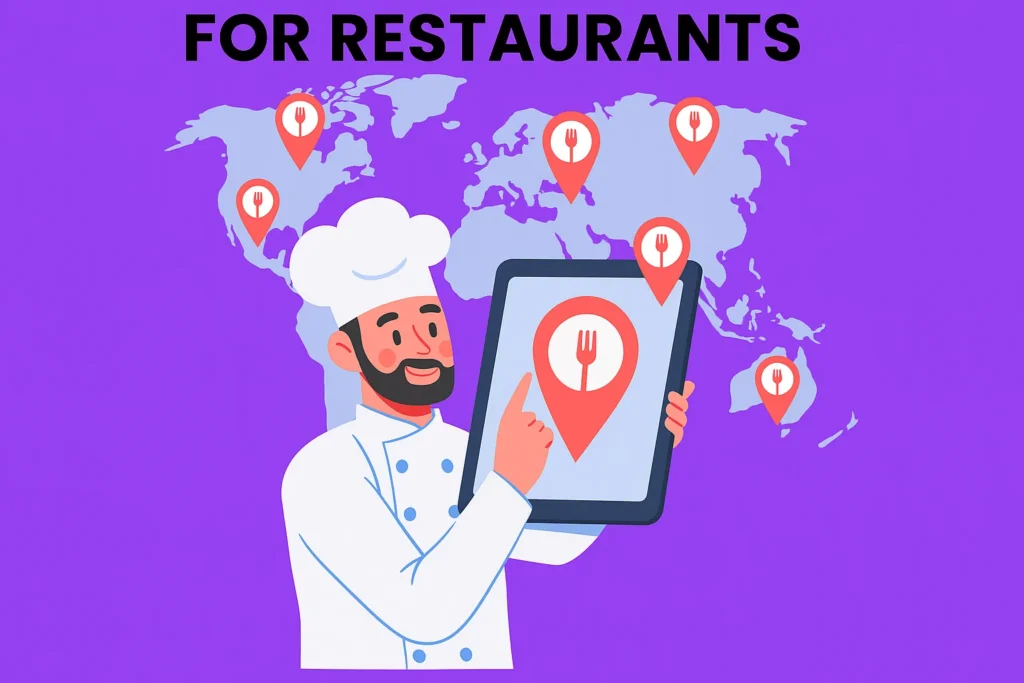In today’s digital era, every business, including restaurants, needs a strong online presence to stand out from the competition. Local SEO (Search Engine Optimization) is particularly vital for restaurants, as it helps them appear in local search results, attract nearby customers, and ultimately drive foot traffic and online orders. This guide will walk you through everything you need to know about local SEO for restaurants, from cost and timeline considerations to strategies for optimizing your website and improving your visibility across various platforms.
What is Local SEO for Restaurants?
Local SEO refers to the process of optimizing your online presence to increase visibility in local search results. For restaurants, this means ensuring that your establishment shows up when potential customers search for relevant keywords, such as “best Italian restaurant near me” or “pizza place in [city name].”

By focusing on location-based search queries, local SEO for restaurants helps to attract nearby customers, especially those who are ready to dine out, make a reservation, or place an order for delivery or takeout.
Why is Local SEO Important for Restaurants?
Restaurants rely heavily on foot traffic and local customers to sustain their business. The key reasons why local SEO is important include:
- Increased Visibility: Local SEO ensures your restaurant appears in local search results, helping potential customers discover you.
- Local Search Intent: Consumers searching for restaurants typically have high purchase intent, meaning they are looking to visit, order, or engage with local businesses.
- Mobile Optimization: Many people search for restaurants on their mobile devices while on the go. Optimizing for local search allows your restaurant to show up in local searches on mobile.
- Competitive Advantage: A strong local SEO strategy can help you outshine competitors in your area who may not be fully utilizing local SEO.
Key Elements of Local SEO for Restaurants
There are several essential components of local SEO that restaurants should focus on. Let’s break these down:
1. Google My Business (GMB)
Google My Business is one of the most critical elements of local SEO. It allows you to manage your restaurant’s information across Google, including search results and Google Maps. Key features of a well-optimized GMB listing include:
- Business name, address, and phone number (NAP consistency)
- Restaurant hours, menu, and photos
- Reviews and ratings
- Q&A section
A well-maintained GMB profile increases your chances of appearing in the “local pack” of Google search results, which is vital for restaurants.
2. On-Page SEO
On-page SEO involves optimizing individual web pages to rank higher and attract more relevant traffic. Important on-page factors include:
- Title tags and meta descriptions: Ensure these are optimized for local search terms.
- Local keywords: Include location-specific keywords in your page content.
- Menu Optimization: If applicable, provide a user-friendly, SEO-friendly version of your menu.
- Schema Markup: Implement structured data like restaurant schema to help search engines better understand your business.
3. Off-Page SEO
Off-page SEO refers to activities that take place outside your website but still impact your rankings. The two most important off-page SEO elements for local businesses are:
- Backlinks: Get local backlinks from community websites, food bloggers, local news outlets, and other reputable sites.
- Social Media: Local SEO benefits from social signals. Active engagement with your audience on social platforms like Instagram and Facebook helps boost visibility.
4. Technical SEO
Technical SEO ensures that your website is optimized for search engines. Key technical factors for restaurants include:
- Mobile responsiveness: Since many users search for restaurants on their phones, ensure your website is mobile-friendly.
- Page speed: A fast-loading website is crucial for user experience and SEO rankings.
- Secure website (HTTPS): Google prioritizes secure websites, so ensure your website has an SSL certificate.
5. Local Citations
Local citations are online mentions of your restaurant’s name, address, and phone number (NAP). Consistent NAP information across multiple directories and platforms helps improve your local search rankings. Common citation sources for restaurants include Yelp, TripAdvisor, and Yellow Pages.
Local SEO Strategies for Restaurants
Now that we’ve covered the fundamentals of local SEO, let’s dive into actionable strategies that can help improve your restaurant’s online visibility.
1. Optimize Your Website for Local Search
Begin by optimizing your website for local search terms. This includes:
- Location-Based Keywords: Use phrases such as “best sushi in [city name]” or “pizza delivery in [neighborhood].”
- Location Pages: If you have multiple locations, create separate pages for each location with relevant local content.
- Mobile Optimization: Ensure your website is mobile-responsive, as many local searches are conducted via smartphones.
2. Claim and Optimize Your Google My Business (GMB) Listing
Claiming your GMB listing is one of the most important steps in local SEO. To optimize it:
- Keep your business information accurate and up-to-date.
- Add high-quality photos of your restaurant, food, and ambiance.
- Regularly update your hours of operation, especially around holidays.
- Encourage customers to leave reviews and respond to them promptly.
3. Use Local Keywords
Integrating local keywords in your website content, blog posts, and social media helps you rank for local search terms. Examples include:
- “Top-rated restaurants in [city name]”
- “Best family-friendly restaurant in [neighborhood]”
- “Best brunch spots near [landmark]”
4. Encourage Online Reviews
Reviews play a significant role in local SEO. Not only do they improve your GMB listing’s visibility, but they also build trust with potential customers. Encourage customers to leave reviews on platforms like Google, Yelp, and TripAdvisor. Be sure to respond to reviews, both positive and negative, to show engagement.
5. Build Local Citations
Ensure your restaurant is listed on reputable local directories like Yelp, Foursquare, and local Chamber of Commerce websites. Keep your NAP consistent across all citations to help improve local SEO rankings.
6. Utilize Social Media for Local Engagement
Social media platforms can drive local engagement by promoting your restaurant to the local community. Regularly share:
- Special promotions
- Local events or festivals
- Behind-the-scenes content, such as food prep or staff introductions
Social media helps foster relationships with local customers, which can translate into higher engagement and visits.
Tools for Local SEO for Restaurants
To efficiently manage your restaurant’s local SEO, several tools can help:
- Google My Business Dashboard: To manage your GMB listing.
- Moz Local: Helps with managing and updating local citations.
- SEMrush or Ahrefs: For keyword research and backlink analysis.
- Google Analytics: To track website traffic and user behavior.
- Yext: For managing local listings across various directories.
- BrightLocal: Specializes in local SEO audits and ranking tracking.
What Our Clients Say
Trusted by contractors and local businesses for proven Local SEO Services.
John M. – General Contractor
“These guys transformed my Google Maps ranking. More calls, more local leads, and better visibility!”
Sarah L. – Roofing Business
“Within 3 months, my business went from page 3 to the top 3 listings. Highly recommend their Local SEO service!”
David K. – Plumbing Services
“Affordable and effective SEO. My local service calls doubled in less than 90 days.”
Costs and Timeline of Local SEO for Restaurants
Cost of Local SEO for Restaurants
The cost of local SEO can vary depending on the size of your restaurant, the level of competition, and whether you handle SEO in-house or hire a professional. On average:
- Do-It-Yourself: Free (apart from tool subscriptions and website hosting fees)
- Hiring a Local SEO Agency: Typically costs between $500 – $2,000 per month.
- Freelancers: You may hire a freelance SEO expert for around $50 – $150 per hour.
Timeline for Local SEO Results
It’s essential to understand that SEO is not an instant process. It can take anywhere from 3 to 6 months to see tangible results from your local SEO efforts. However, improvements in visibility and rankings should be noticeable within the first few months.
FAQs on Local SEO for Restaurants
Q1: How do I get my restaurant listed on Google?
To get your restaurant listed on Google, claim and optimize your Google My Business (GMB) listing with accurate details about your business, including your name, address, phone number, website, hours of operation, and photos.
Q2: How can I get more reviews for my restaurant?
Encourage satisfied customers to leave reviews on platforms like Google and Yelp. Make it easy by sending follow-up emails or including review links on your website and social media. Respond to all reviews, whether they’re positive or negative.
Q3: Is it important to have a website for my restaurant?
Yes! A website helps establish credibility and provides customers with essential information such as your menu, hours, location, and contact details. A well-optimized website is key to ranking higher in search results.
Q4: Can social media help with local SEO for restaurants?
Absolutely! Engaging with local customers through social media platforms like Facebook and Instagram helps build relationships and boost your restaurant’s visibility.
Conclusion
Incorporating a strong local SEO strategy for your restaurant is essential for attracting nearby customers and standing out in a competitive market. By focusing on optimizing your website, claiming and managing your Google My Business profile, utilizing local keywords, encouraging reviews, and leveraging social media, you can improve your restaurant’s online presence and increase foot traffic. Remember, local SEO is an ongoing effort, but with consistent optimization, your restaurant can achieve long-term success in the digital space.

Gulfam Qamar is a seasoned Local SEO expert with a proven track record of helping businesses boost their online visibility and dominate local search results. With deep expertise in Google Business Profiles, on-page optimization, and local citation strategies, Gulfam helps brands connect with nearby customers and grow sustainably. When he’s not optimizing websites, he’s sharing actionable SEO tips and insights to empower small businesses in the digital space.

